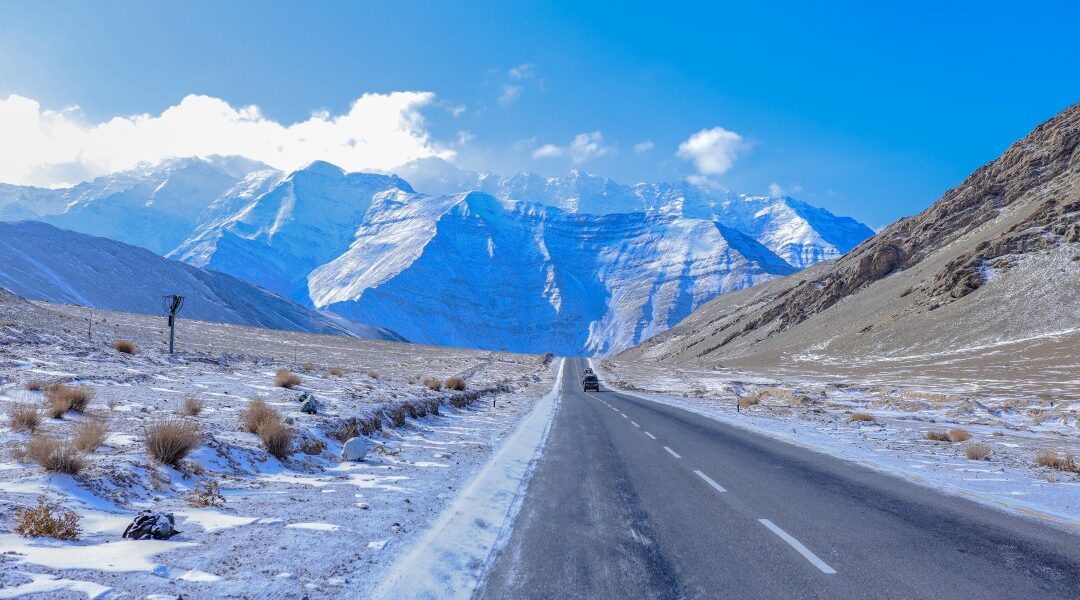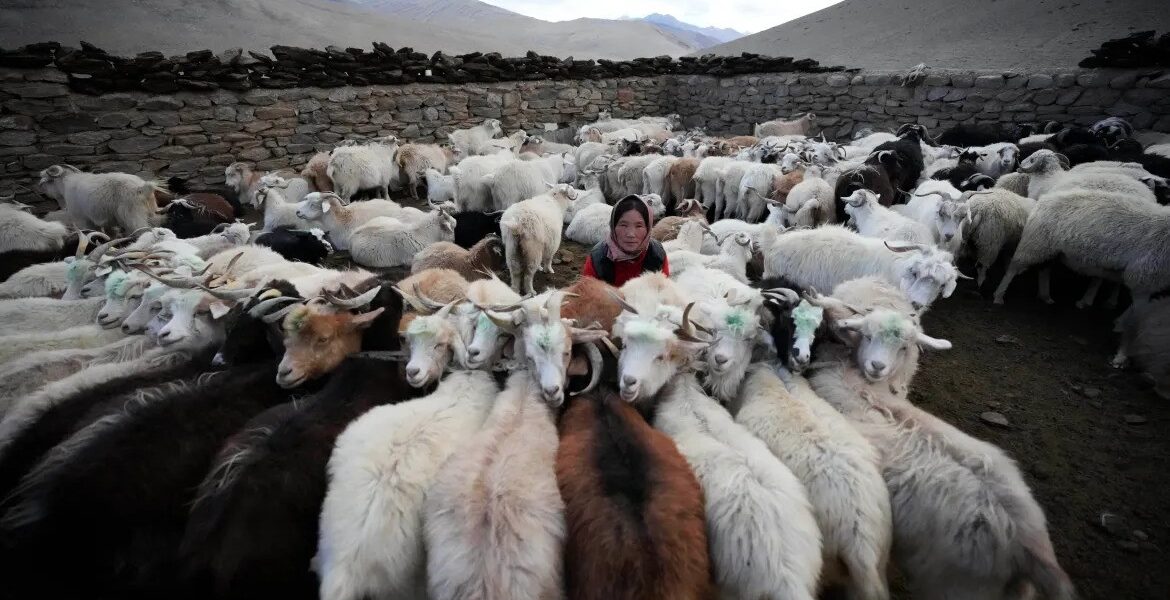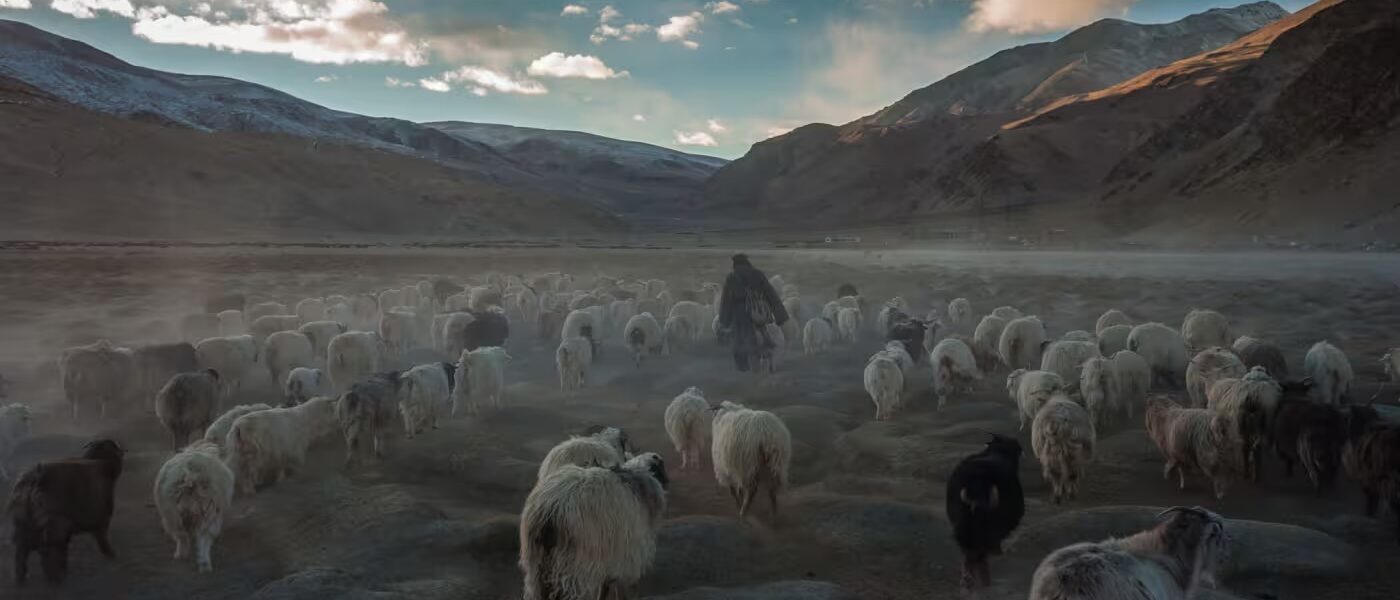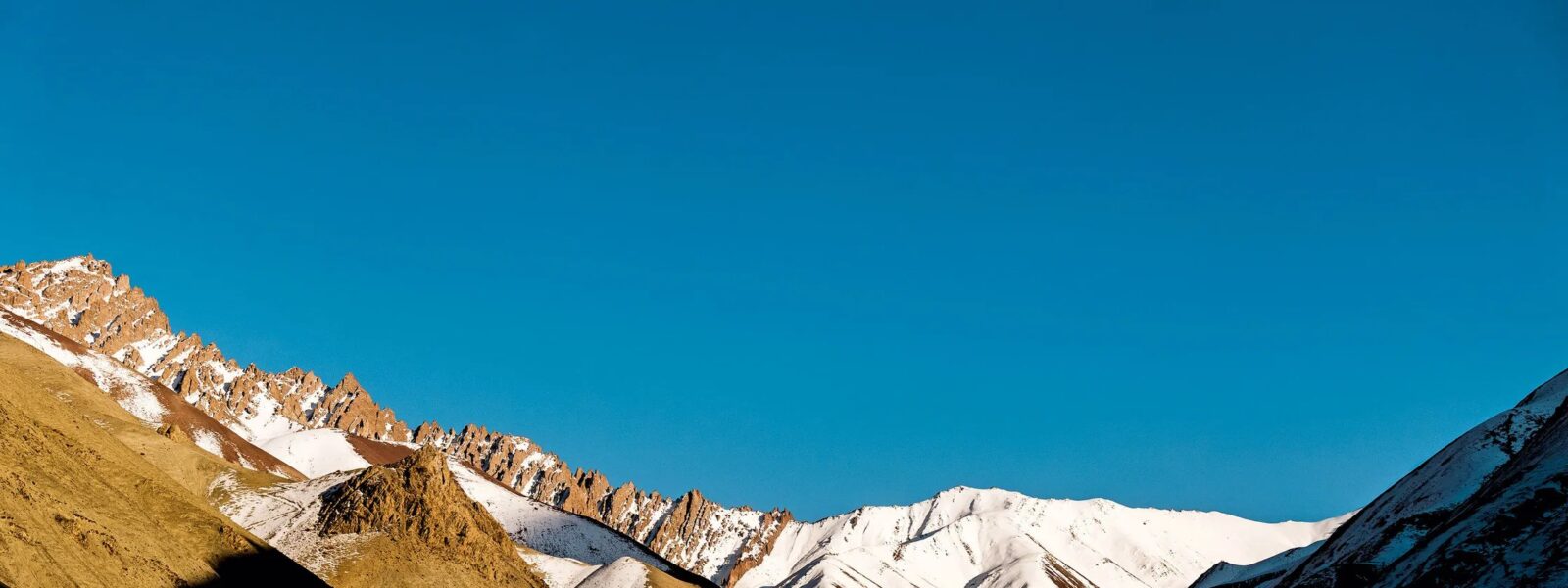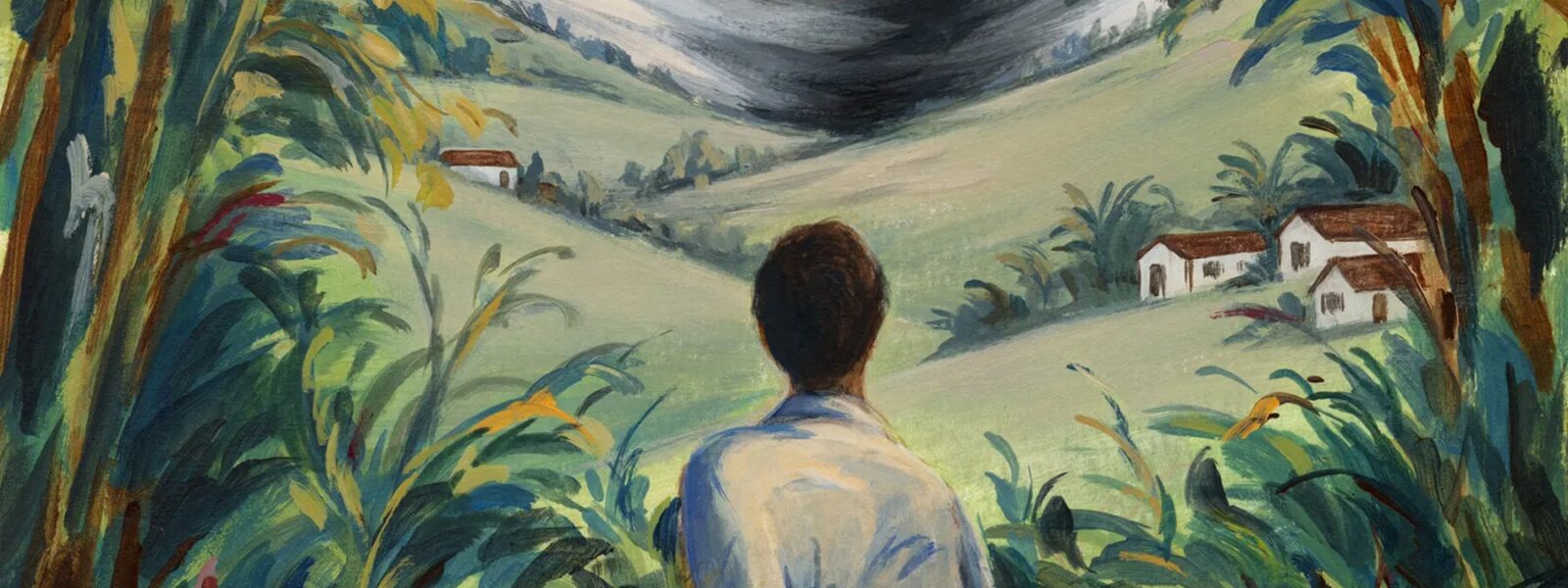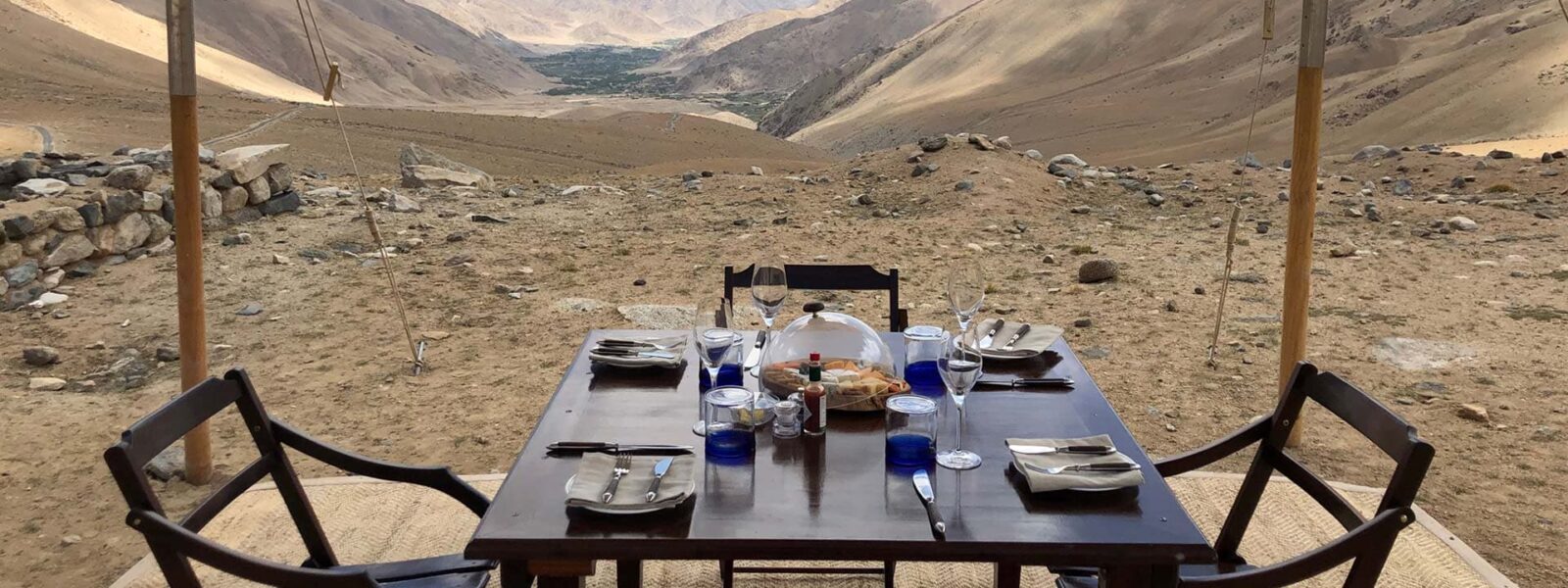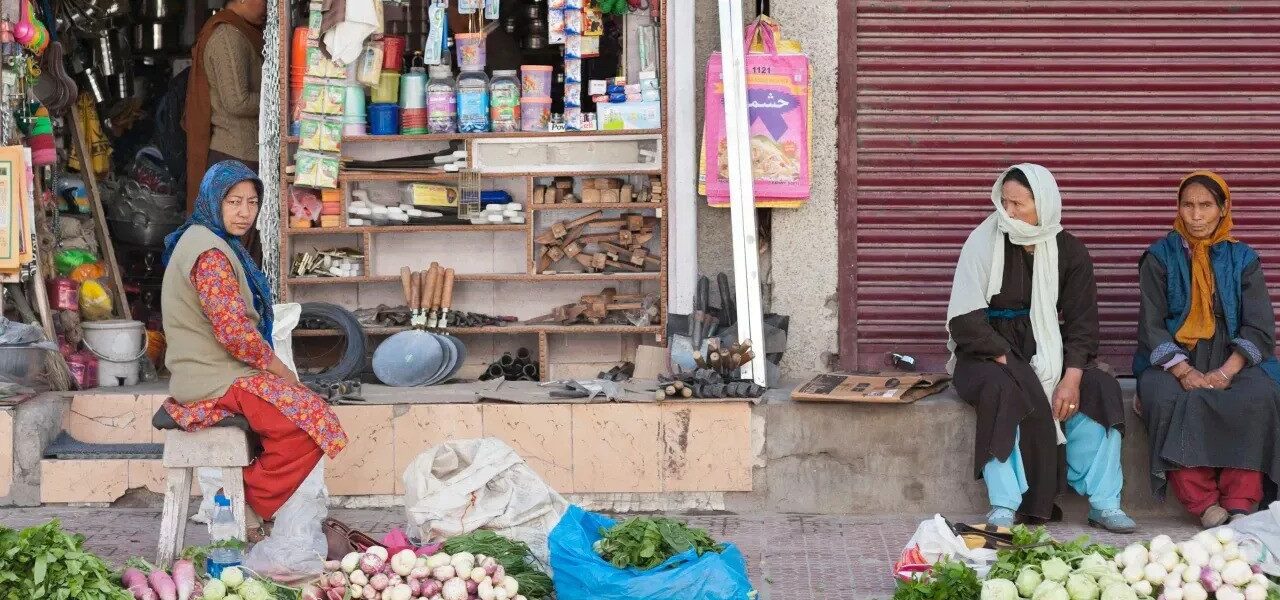Why Choose the Manali to Leh Road Trip?
The road from Manali to Leh isn’t just a route—it’s a transformative journey that captures the soul of the Indian Himalayas. For many travelers, this trans-Himalayan adventure is a rite of passage, connecting the lush green valleys of Himachal Pradesh to the stark, lunar landscapes of Ladakh. What sets this trip apart is the sheer diversity of landscapes, cultures, and experiences it offers in just a few hundred kilometers.
This isn’t just a drive—it’s an odyssey. You’ll pass through a mesmerizing sequence of mountain passes, high-altitude plateaus, ancient monasteries, and remote villages that appear frozen in time. The Manali to Leh highway is one of the most scenic and challenging roads in the world, ascending to over 5,000 meters in altitude. It’s a test of spirit, planning, and endurance, but the rewards are immense. Every turn reveals a new wonder—from the lush greenery of Kullu Valley to the desolate grandeur of Sarchu and the golden hues of More Plains.
A major highlight is crossing five major mountain passes: Rohtang La, Baralacha La, Nakee La, Lachulung La, and Tanglang La. Each pass brings with it a change in climate, scenery, and elevation. Rohtang Pass, often cloaked in mist and snow, is your first challenge. As you ascend, the air thins, the colors fade to brown and grey, and you’re left with only the sound of the wind and your thoughts. It’s this meditative quality that draws not just adventure seekers, but also those in search of inner stillness.
This road trip also serves as a gateway to Ladakh’s most iconic destinations. Upon reaching Leh, you’ll find yourself at the doorstep of places like Nubra Valley, Pangong Lake, and Khardung La. But it’s not just about reaching the destination—it’s the journey that defines the experience. The rugged beauty of the Manali Leh highway is both humbling and empowering, reminding travelers of their smallness against the backdrop of mighty mountains.
Whether you’re an avid motorcyclist, a first-time road tripper, or a photographer chasing light in the Himalayas, this journey offers a perfect blend of thrill and serenity. Many travelers return not just with photos, but with a new perspective on life. That’s what makes the Manali to Leh road trip more than just a travel route—it’s a story written across the clouds, peaks, and prayers fluttering in the wind.
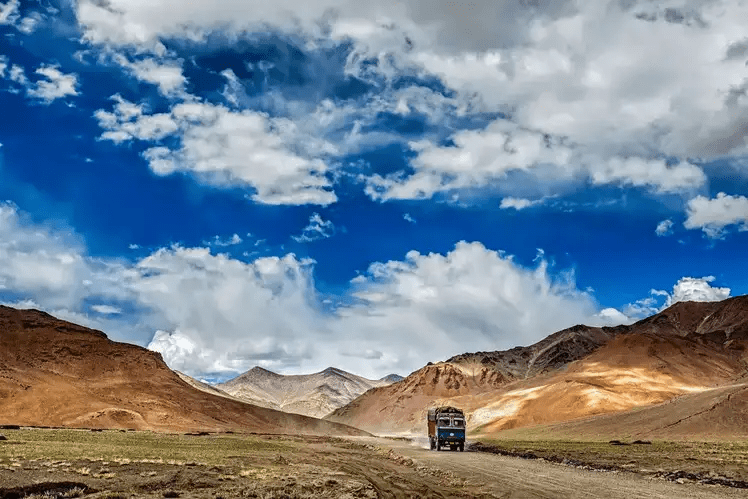
Best Time to Travel from Manali to Leh
Timing is everything when planning a road trip through the Himalayas. The Manali to Leh highway is only open for a few precious months each year, and choosing the right window can make or break your journey. Due to extreme weather and heavy snowfall, this route remains inaccessible for most of the year, typically opening around late May or early June and closing by mid-October. The best time to travel depends on your goals—whether you seek lush greenery, snow-covered peaks, minimal crowds, or the clearest skies.
June to mid-July is the season of freshness. As the snow starts to melt, the valleys bloom with wildflowers, streams run high with glacial melt, and the air carries a crisp, earthy scent. However, early in the season, you may still encounter snow walls at high passes like Baralacha La and Tanglang La, which adds to the adventure but can slow down progress. These weeks are ideal for those who want to witness the transition from winter to summer.
Mid-July to August marks the heart of summer, offering the most stable weather conditions. The roads are generally clear of snow, the skies are blue, and the journey becomes relatively smoother. This is when most travelers, bikers, and photographers embark on the trip. However, keep in mind that July and August also bring the risk of monsoon rains on the Manali side, which can lead to landslides and slippery roads. While Ladakh itself is a rain shadow zone, the journey up to Rohtang Pass and beyond may still pose occasional challenges.
September to mid-October is perhaps the most underrated and rewarding time to go. The tourist crowds thin out, the landscape starts changing into autumn colors, and the visibility is unparalleled. The golden hues of the high-altitude plains and the changing colors of the valleys create a dramatic backdrop for the journey. Moreover, road conditions are at their best, making this period highly recommended for travelers who want serenity without compromising on safety.
Planning your departure and return around these months is crucial. It’s also important to monitor the official status of the highway, as unexpected weather changes can affect accessibility. Always check with local authorities or road condition updates from BRO (Border Roads Organisation) before starting the journey.
Remember, even in peak season, the Manali to Leh road trip is a high-altitude journey that requires proper acclimatization and preparedness. Starting early in the morning, keeping a flexible schedule, and allowing time for unforeseen delays will help ensure a memorable and stress-free experience.
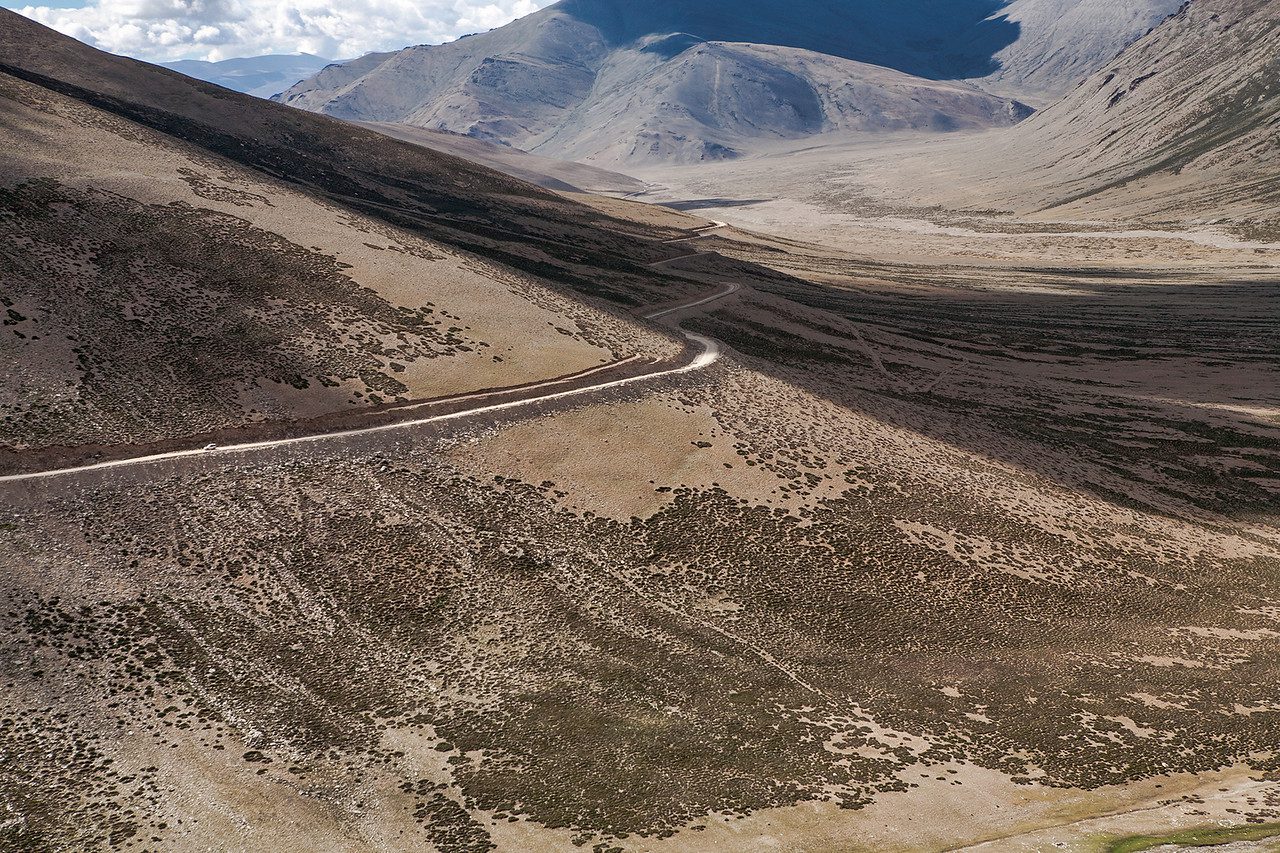
Route Overview: Distance, Time & Road Conditions
The journey from Manali to Leh covers a total distance of approximately 470 kilometers, but don’t let the numbers fool you. This is no ordinary highway. Winding through five of the world’s highest motorable mountain passes, glacial streams, and remote valleys, this route demands time, patience, and respect for the mountains.
Depending on road conditions and your pace, the trip typically takes 2 to 3 days. While some adventure bikers push through in a single stretch, this is not advisable for most travelers due to the high altitude and risk of Acute Mountain Sickness (AMS). The ideal plan is to break the journey into multiple segments, with overnight stops in Keylong, Jispa, Sarchu, or Pang to allow for rest and acclimatization.
The route begins in Manali, nestled in the lush green Kullu Valley, and immediately starts ascending towards Rohtang Pass (3,978m). From here, the landscape transforms drastically. As you cross into Lahaul Valley, the terrain becomes barren, dramatic, and uniquely Himalayan. The next significant milestone is Keylong, the administrative hub of the Lahaul region, followed by the tranquil village of Jispa.
After Jispa, the climb intensifies as you approach Baralacha La (4,890m), often snow-covered even in summer. Beyond this lies the high-altitude desert of Sarchu, a popular camping zone. Then comes the twin passes—Nakee La (4,739m) and Lachulung La (5,059m)—before descending briefly into Pang. Here, the road stretches across the surreal flatlands of the More Plains, a high-altitude plateau resembling another planet.
Your final climb takes you up to Tanglang La (5,328m), the second-highest motorable pass on this route. Once over the top, the descent into the Indus Valley begins, leading to the picturesque approach toward Leh, the capital of Ladakh.
Road conditions vary greatly along the way. The Manali Leh highway is maintained by the Border Roads Organisation (BRO) and is generally drivable from June to October. However, rough patches, water crossings, unpaved sections, and landslides are common—especially near Rohtang, Baralacha La, and Pang. Asphalt gives way to gravel in many parts, and river crossings can become dangerous after afternoon melt. Driving a 4×4 or high-clearance vehicle is highly recommended.
Preparation is everything. From fuel and food to altitude preparedness and mechanical readiness, every detail matters on this route. Keep your itinerary flexible, check daily road status updates, and always respect the pace of the mountains.
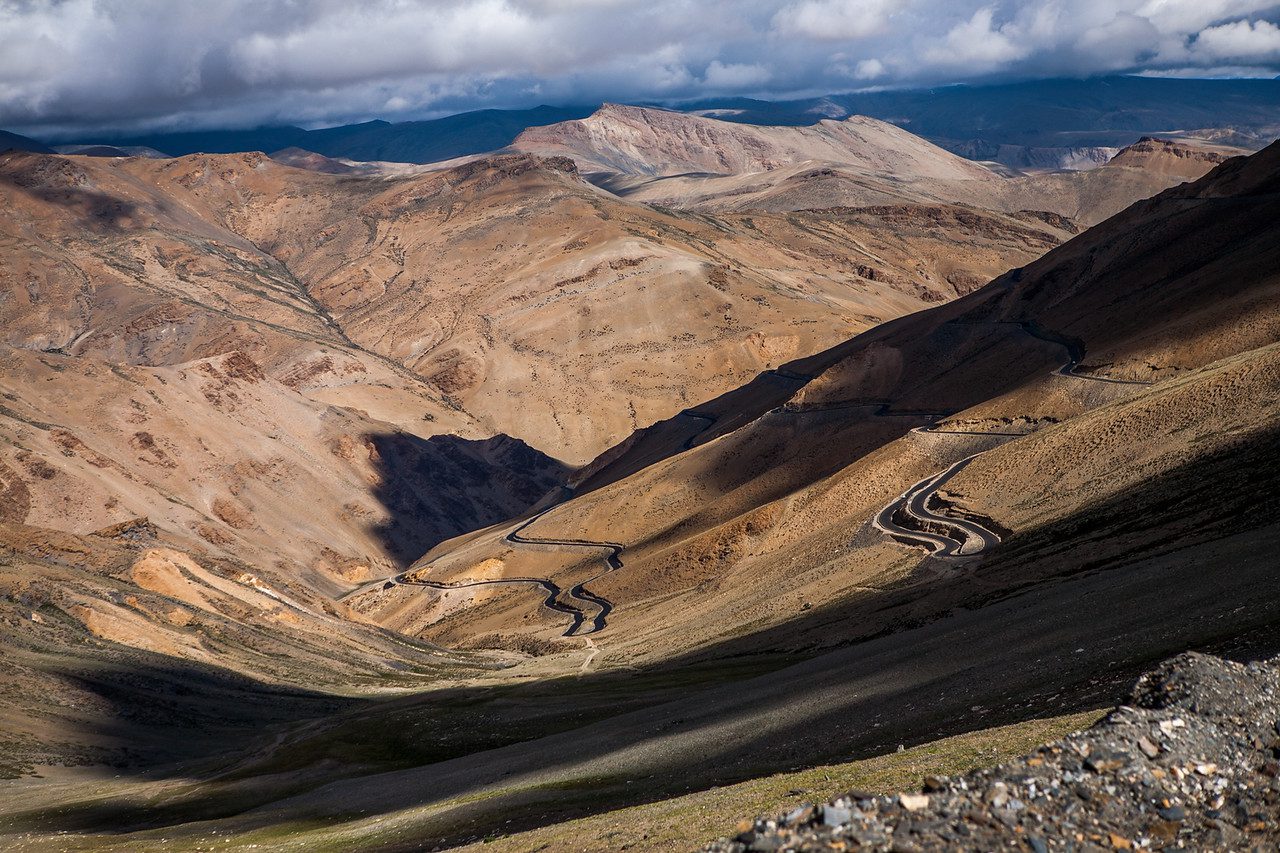
Required Permits and Documents
Before embarking on the Manali to Leh road trip, it’s essential to understand the permit requirements that apply along this high-altitude journey. Due to the proximity of the route to international borders and environmentally sensitive zones, permits are strictly enforced at several points. Having the right paperwork not only avoids delays but also ensures a safe and lawful passage through restricted areas.
1. Rohtang Pass Permit (for Non-Himachal Vehicles):
If you’re starting your trip from Manali and intend to cross Rohtang La (3,978m), you will need a Rohtang Pass Permit. This is especially applicable for petrol and diesel vehicles registered outside Himachal Pradesh. The permit can be obtained online through the official Rohtang Permit Portal, and is required only for vehicles going beyond Rohtang Pass towards Keylong and Leh. Note that this permit is not required for returning to Manali from Leh.
Permits are limited per day to reduce environmental damage, so it’s advisable to book in advance. You’ll need to provide your vehicle registration number, pollution certificate, and driver’s license details while applying.
2. Inner Line Permit (ILP) – For Areas Beyond Leh:
While you do not need an ILP for the direct route from Manali to Leh, once you reach Leh and wish to explore regions such as Nubra Valley, Pangong Lake, Tso Moriri, or Hanle, the Inner Line Permit becomes mandatory. ILPs can be obtained from the DC Office in Leh or via the Ladakh Administration Website. Indian citizens and foreign nationals have different forms and fees, and it’s important to carry both hard and soft copies while on the move.
3. Wildlife and Green Tax:
Tourists entering Manali must pay a Green Tax at the entry checkpoint. Additionally, travelers are required to pay a wildlife protection fee while traveling in Ladakh. These fees contribute to environmental conservation and are collected either at official checkpoints or online, depending on the region.
4. Checklist of Required Documents:
To ensure a smooth journey, keep the following documents accessible throughout the trip:
- Original and photocopy of your driver’s license
- Vehicle Registration Certificate (RC)
- Pollution Under Control (PUC) Certificate
- Valid Insurance Papers
- Rohtang Pass Permit (if applicable)
- Inner Line Permit for restricted areas
- Government-issued ID proof (Aadhaar, Passport, etc.)
- Passport and valid visa for foreign nationals
5. Checkpoints and Inspections:
Multiple police and army checkpoints exist between Manali and Leh. You’ll need to show ID and permits at Gulaba, Darcha, Sarchu, Pang, and Upshi. Keep at least 4–5 photocopies of your permits and ID cards, especially when traveling in groups or riding separately.
Having your documents ready and neatly organized can save valuable time and minimize stress on the road. Remember, these regulations are in place not just for security but also to preserve the fragile ecosystem and ensure traveler safety in this remote region.
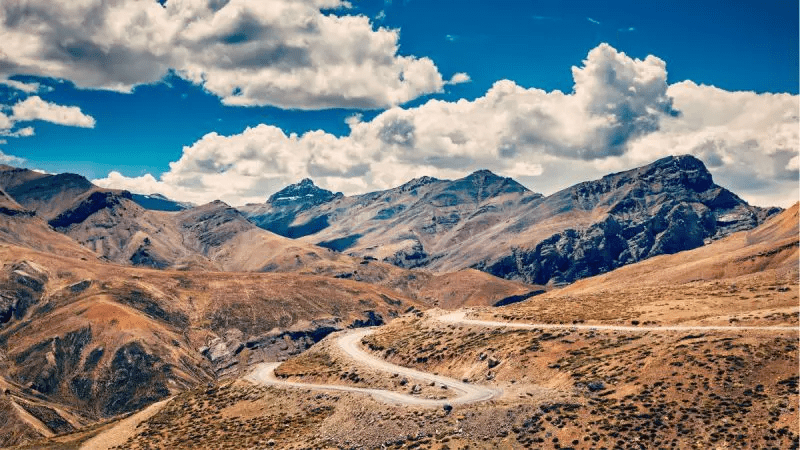
Best Scenic Stops on the Manali to Leh Route
The journey from Manali to Leh is not just about getting from one place to another—it’s about the stops you make along the way. These scenic halts are more than rest points; they’re windows into the soul of the Himalayas. From lush valleys and quaint villages to rugged desert plateaus and high-altitude campsites, every stop has its own rhythm, color, and story. Here are the most recommended scenic stops that make this road trip unforgettable.
Keylong – The Lahaul Hub:
Your first major stop after crossing the majestic Rohtang Pass is Keylong, a small but bustling town nestled in the Lahaul Valley. It is the administrative center of the region and offers basic guesthouses, fuel stations, and grocery shops. The backdrop of snow-capped peaks and the Bhaga River flowing nearby makes this a peaceful yet practical stopover. Travelers often spend the night here to break their journey and allow for initial altitude acclimatization.
Jispa – Riverside Calm and Mountain Silence:
About 20 kilometers beyond Keylong lies Jispa, a picturesque hamlet known for its scenic riverside camps and serene environment. It’s one of the most loved overnight stops, especially for bikers and nature lovers. You can walk along the riverbanks, enjoy a peaceful bonfire, or simply stare into the stars. The altitude here (3,200m) is ideal for gradual acclimatization before the road climbs further.
Darcha – The Last Checkpoint of Himachal:
As you head north, Darcha marks the final significant village in Himachal Pradesh. It’s also a key checkpoint where permits and documents are often verified. While not a major tourist spot, it’s strategically important and provides a final chance to stock up on essentials or get your documents sorted before entering the more desolate stretches ahead.
Baralacha La & Suraj Tal – Where Ice Meets Sky:
Crossing the high-altitude Baralacha La (4,890m) is one of the most memorable parts of this journey. Just before the summit, you’ll encounter Suraj Tal, one of the highest lakes in India. Often partially frozen even in summer, the lake is framed by towering peaks and deep silence. A short break here feels like stepping onto another planet.
Sarchu – Camps Under a Thousand Stars:
Sarchu sits on the border between Himachal and Ladakh and is one of the most popular overnight campsites. At 4,200 meters, it’s cold, dry, and starkly beautiful. Rows of luxury and budget tents line the plain, offering one of the most surreal camping experiences in India. Sarchu is also a key location for altitude adjustment before crossing the higher passes ahead.
Pang – Gateway to the More Plains:
After a series of dramatic switchbacks and steep climbs, you’ll descend into the windswept valley of Pang. This small military outpost and seasonal tent village is surrounded by rock formations and surreal landscapes. It’s a good spot to rest, eat, and hydrate before continuing across the high-altitude plateau ahead.
More Plains – The Himalayan Highway to the Sky:
Stretching for nearly 40 kilometers, the More Plains is a flat, open expanse at an altitude of 4,700 meters. The landscape here is dreamlike—endless skies above, golden desert around, and a ribbon of black tarmac cutting through it all. It’s the perfect spot for photography, drone shots (if permitted), and simply absorbing the overwhelming vastness.
Tanglang La – The Last Great Climb:
As you approach Leh, one final test awaits—Tanglang La (5,328m), the second-highest motorable pass on this route. With panoramic views stretching across Ladakh, this pass is both a challenge and a reward. Most travelers stop here for a quick photo and a deep breath before descending into the Indus Valley and reaching Leh.
Each of these stops offers something different—beauty, rest, culture, or just a chance to connect with the road. Planning your journey around them ensures not only a safer trip but also a richer, deeper experience of the Manali to Leh highway.
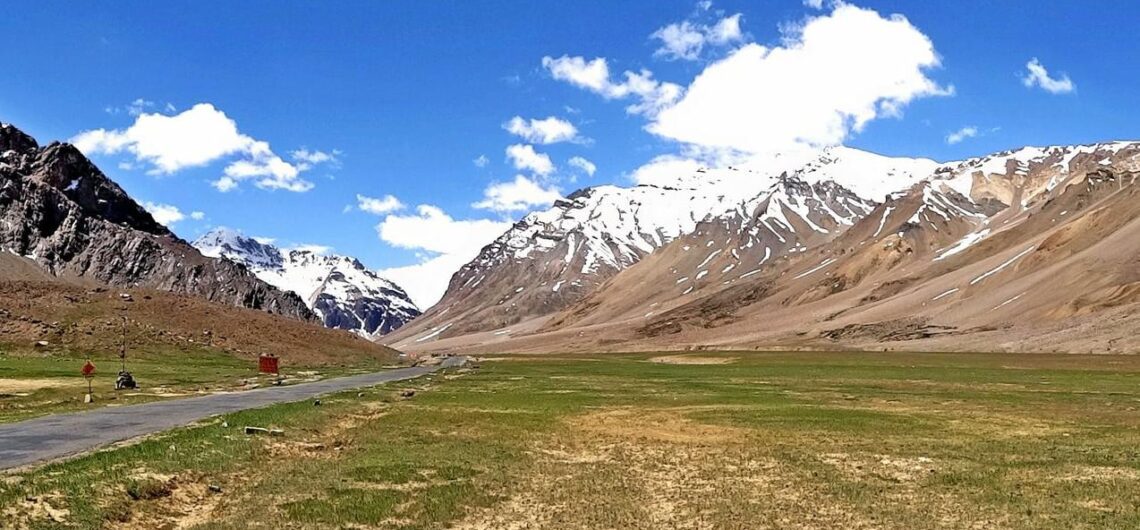
Fuel, Food & Accommodation Guide
Planning your fuel, food, and accommodation stops carefully is not just convenient—it’s critical for survival on the Manali to Leh road trip. Once you cross Rohtang Pass, you enter one of the most remote regions of India, where services are sparse and distances between facilities are long. This guide will help you stay fueled, fed, and well-rested throughout the journey.
Fuel Stops – Plan Ahead, Drive Smart:
One of the most common mistakes travelers make is underestimating the fuel requirement. After Manali, the last dependable fuel station is at Tandi, just before Keylong. It’s essential to top up here because the next official petrol pump is in Karzu, Leh, approximately 350 km away. Carrying an extra 5–10 liters of fuel in a jerry can is highly recommended, especially if you’re riding a bike or driving a vehicle with limited tank capacity. Though a few local vendors may sell petrol in barrels at Darcha or Sarchu, they are unreliable and often overpriced.
Food Along the Way – From Dhabas to Army Cafés:
The culinary experience on this route is rustic but satisfying. You’ll find small dhabas and roadside cafés offering simple meals like dal-chawal, Maggi noodles, momos, and chai. Notable food stops include:
- Koksar: Local Himachali dishes and fresh thukpa.
- Keylong & Jispa: Several restaurants attached to guesthouses offering hot food and decent hygiene.
- Sarchu & Pang: Tent cafés serving instant noodles, tea, boiled eggs, and snacks.
- Army-run canteens (if accessible): Known for warmth, cleanliness, and low prices.
Don’t forget to stock up on dry fruits, energy bars, chocolates, and biscuits from Manali as backup, especially for long stretches between Sarchu and Pang.
Accommodation – Rest Where It Matters Most:
Where you sleep on this journey can affect both your energy and altitude acclimatization. Here’s a quick breakdown:
- Keylong: Offers basic hotels and government rest houses. Ideal for those seeking minimal elevation on the first day.
- Jispa: Popular among bikers. Options range from riverside camps to mid-range guesthouses. Great for stargazing.
- Sarchu: Known for tented camps. Due to high altitude (4,200m), overnight stays are not recommended for those prone to altitude sickness.
- Pang: Simple accommodation in seasonal tents. Better suited as a food or rest stop rather than an overnight stay.
For budget travelers, homestays in smaller villages like Darcha are also available during peak season. Booking in advance is not mandatory but advised in July and August.
Most accommodations offer only basic amenities—expect no Wi-Fi, limited electricity, and shared bathrooms. However, what they lack in luxury, they make up for in hospitality and location. Waking up to the sound of mountain rivers or stepping outside to a sky full of stars is part of what makes this road trip unforgettable.
Proper planning around fuel, food, and rest stops turns a challenging drive into a smooth adventure. This triad—gas, grub, and a good night’s sleep—is your lifeline in the Himalayas.
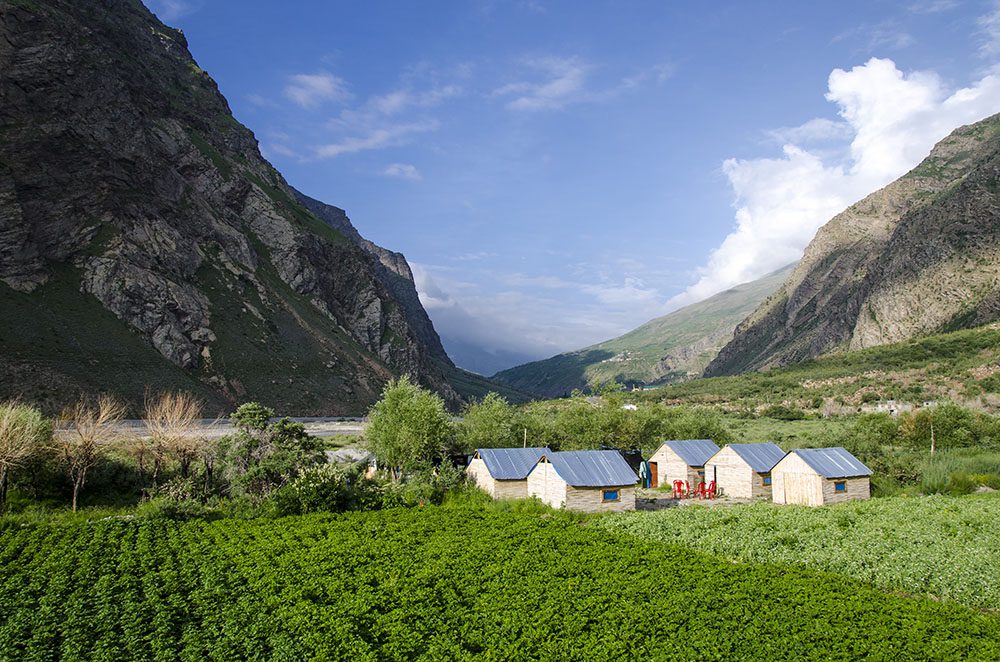
Health and Safety on the Road
Traveling from Manali to Leh is an adventure of a lifetime—but it’s not without risks. From high altitude and sudden weather changes to vehicle breakdowns in remote areas, the journey demands not only physical readiness but mental alertness. This section outlines the essential health precautions and safety measures to ensure your Himalayan road trip is both exhilarating and secure.
1. Altitude Sickness (AMS) – Know the Signs:
One of the most common challenges on the Manali to Leh route is Acute Mountain Sickness (AMS), which typically affects travelers above 3,000 meters. Symptoms include headache, dizziness, fatigue, nausea, shortness of breath, and loss of appetite. As you ascend to places like Baralacha La, Sarchu, Pang, and Tanglang La—all above 4,500m—the risk becomes real.
To reduce your risk of AMS:
- Spend at least one night in Keylong or Jispa for acclimatization.
- Stay hydrated—drink at least 3-4 liters of water per day.
- Avoid alcohol and smoking during the ascent.
- Ascend slowly and take frequent breaks.
- Carry Diamox or consult your doctor before the trip.
2. Oxygen and First-Aid:
Portable oxygen cans and pulse oximeters are highly recommended for those who are sensitive to high altitudes. Most pharmacies in Manali and Leh sell basic medical kits, but it’s better to pack your own. Your first-aid kit should include:
- Painkillers, altitude tablets, anti-diarrheal, and motion sickness pills
- Bandages, antiseptic cream, Dettol, and hand sanitizer
- Personal medication with doctor’s prescription
- Rehydration salts and energy gels
Also, inform your fellow travelers about any allergies or medical conditions you have.
3. Emergency Contacts and Health Facilities:
While medical facilities are limited on the route, a few options exist:
- Keylong District Hospital – Basic care and emergency services
- Army Medical Posts – Found at Sarchu, Pang, and Tanglang La (when active)
- Leh SNM Hospital – Full-service hospital upon arrival in Ladakh
In case of emergencies, dial 108 (pan-India ambulance) or inform the nearest army checkpoint.
4. Road Safety Tips for the Mountains:
The Manali Leh highway is not an ordinary road. Narrow hairpin bends, rockfalls, river crossings, and changing weather make it essential to drive with extra care. Here are tips to stay safe:
- Start early (before 6:30 AM) to avoid afternoon water crossings and changing weather.
- Drive slowly—speeding on these roads is extremely dangerous.
- Use low gear during downhill stretches to avoid brake failure.
- Do not overtake on blind curves or near cliff edges.
- Respect BRO workers and road maintenance crews—follow their instructions.
5. Mental Preparedness:
Isolation, fatigue, and discomfort are part of the package. Expect to be offline for most of the journey. Be patient with delays, be prepared for minimal facilities, and embrace the wilderness mindset. It’s what makes this road trip one of the most memorable in the world.
Health and safety may not be the most glamorous part of travel planning, but in Ladakh, it’s the foundation for a successful trip. Respect the altitude, trust your instincts, and always prioritize wellbeing over the rush to reach the next milestone.
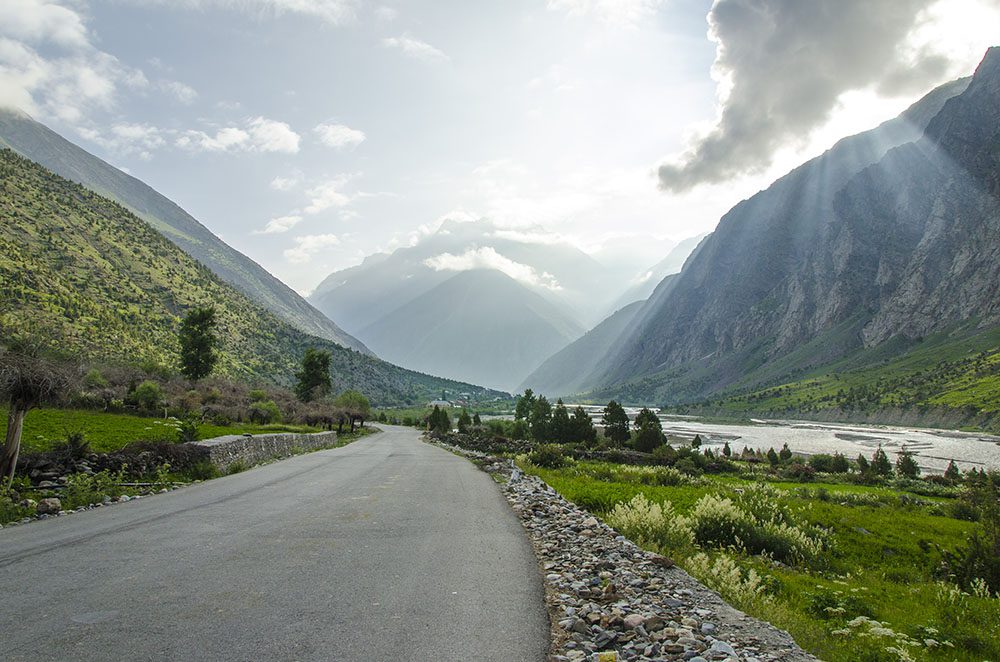
Must-Have Packing List for the Road Trip
Preparing for the Manali to Leh road trip is not just about excitement—it’s about smart packing. The terrain is wild, the weather is unpredictable, and basic amenities are few and far between. Whether you’re traveling by car, motorcycle, or with a support vehicle, packing the right gear can make your journey smooth, safe, and memorable. This detailed packing list ensures you’re ready for every twist and turn along this high-altitude highway.
1. Clothing – Layer Smart, Stay Warm:
Temperatures can vary from 30°C in the sun to sub-zero at night, especially in places like Sarchu or Pang. The key is to layer:
- Thermal base layers (top & bottom)
- Fleece jacket or light down jacket
- Windproof/waterproof outer shell
- Comfortable trekking pants and quick-dry T-shirts
- Woolen socks, gloves, and a warm beanie
- UV-protection sunglasses and a sun hat
Pro tip: Carry a small laundry pouch with detergent for handwashing clothes mid-trip.
2. Footwear – Support and Protection:
The route involves rocky terrain, cold winds, and possible river crossings.
- Sturdy hiking or trekking boots with ankle support
- Flip-flops or sandals for camps and rest breaks
- Extra pair of woolen socks
3. Health and Personal Care:
At high altitude, personal care becomes crucial. Pack:
- High SPF sunscreen and lip balm
- Hand sanitizer, wet wipes, and biodegradable soap
- Toilet paper, tissue rolls, and waste bags
- Basic first-aid kit (band-aids, antiseptic cream, fever & pain meds)
- Altitude sickness tablets (Diamox), motion sickness pills, and ORS
- Any prescribed medication (carry extra)
4. Documents & Money:
Always carry both digital and printed copies of the following:
- Government-issued ID (Aadhaar/Passport)
- Driver’s License
- Vehicle Registration Certificate (RC)
- Pollution and Insurance documents
- Rohtang Pass Permit & Inner Line Permit (if required)
- 5–6 passport-size photos (for emergencies or permits)
- Cash in small denominations (ATMs are rare after Manali)
5. Electronics & Navigation:
Connectivity will be limited, so plan ahead:
- Power bank (10,000mAh or higher)
- Car/motorbike mobile charger
- Offline maps (Google Maps offline or MAPS.ME)
- Headlamps or torches with extra batteries
- DSLR or action camera for unforgettable shots
Jio and BSNL work best in Ladakh, but expect total signal blackouts in Sarchu, Pang, and remote valleys.
6. Food & Hydration:
Staying hydrated and energized is crucial at high altitude.
- Reusable water bottle and purification tablets
- Dry fruits, energy bars, glucose powder
- Instant noodles, soup sachets, and ready-to-eat snacks
- Flask for carrying hot drinks
7. Emergency & Vehicle Essentials:
Breakdowns or emergencies can happen far from help. Be prepared with:
- Spare tire, jack, and basic tool kit
- Tow rope, air pump, tire puncture kit
- Engine oil, coolant, and brake fluid
- Jerry can with spare fuel (especially bikes)
- Rope, duct tape, and zip ties
This road trip isn’t your average weekend drive. Packing right can make all the difference between a comfortable adventure and a survival challenge. Always remember: in the Himalayas, it’s better to have and not need than to need and not have.
Suggested Itinerary: Manali to Leh in 3 to 5 Days
The Manali to Leh road trip is not about rushing—it’s about soaking in the beauty, acclimatizing to the altitude, and embracing the journey. Depending on your time, health, and travel style, you can choose from a 3-day express drive to a relaxed 5-day experience. Here’s a detailed itinerary for each option, allowing you to plan your trip wisely and safely.
Option 1: 3-Day Itinerary – Fast-Paced, High Adrenaline
This itinerary is best for experienced travelers or bikers who are accustomed to high-altitude travel and short rest periods.
- Day 1: Manali – Keylong – Jispa (Approx. 140 km / 6-8 hours)
Depart early to cross Rohtang Pass and reach Keylong. Stay overnight at Jispa for light acclimatization. - Day 2: Jispa – Baralacha La – Sarchu – Pang (Approx. 180 km / 8-10 hours)
A challenging day with multiple high passes. Overnight at Pang (recommended only for seasoned travelers). - Day 3: Pang – More Plains – Tanglang La – Leh (Approx. 150 km / 6-8 hours)
Start early, enjoy surreal landscapes, and arrive in Leh by evening.
Note: Not recommended for those sensitive to altitude or first-time travelers.
Option 2: 4-Day Itinerary – Balanced & Practical
A well-paced plan allowing for better rest and acclimatization. Ideal for most travelers.
- Day 1: Manali – Keylong – Jispa (Stay at Jispa)
- Day 2: Jispa – Baralacha La – Sarchu (Stay at Sarchu)
- Day 3: Sarchu – Pang – More Plains – Upshi (Stay at Upshi or nearby village)
- Day 4: Upshi – Leh (Short 50 km drive to reach Leh early)
This plan reduces the risk of AMS and allows more scenic breaks.
Option 3: 5-Day Itinerary – Comfortable & Immersive
The perfect plan for families, photographers, and anyone wanting to experience the route in depth.
- Day 1: Manali – Keylong (Explore monastery and Bhaga River)
- Day 2: Keylong – Jispa (Short drive + village walk + riverside camping)
- Day 3: Jispa – Baralacha La – Sarchu (Enjoy Suraj Tal and high-altitude views)
- Day 4: Sarchu – Pang – More Plains – Tanglang La (Stay at Rumtse or Upshi)
- Day 5: Upshi – Leh (Reach Leh refreshed and acclimatized)
This itinerary provides the most comfortable pace and best photo opportunities, with time to truly feel the spirit of the Himalayas.
Travel Tips for All Itineraries:
- Start early each day to avoid river crossings and bad weather.
- Listen to your body—rest if altitude symptoms appear.
- Avoid alcohol until you’ve acclimatized in Leh.
- Always keep 1–2 buffer days in your overall Ladakh plan.
No matter which itinerary you choose, the journey from Manali to Leh will reward you with experiences you’ll carry for a lifetime. Choose the pace that suits you, and let the mountains guide the rest.
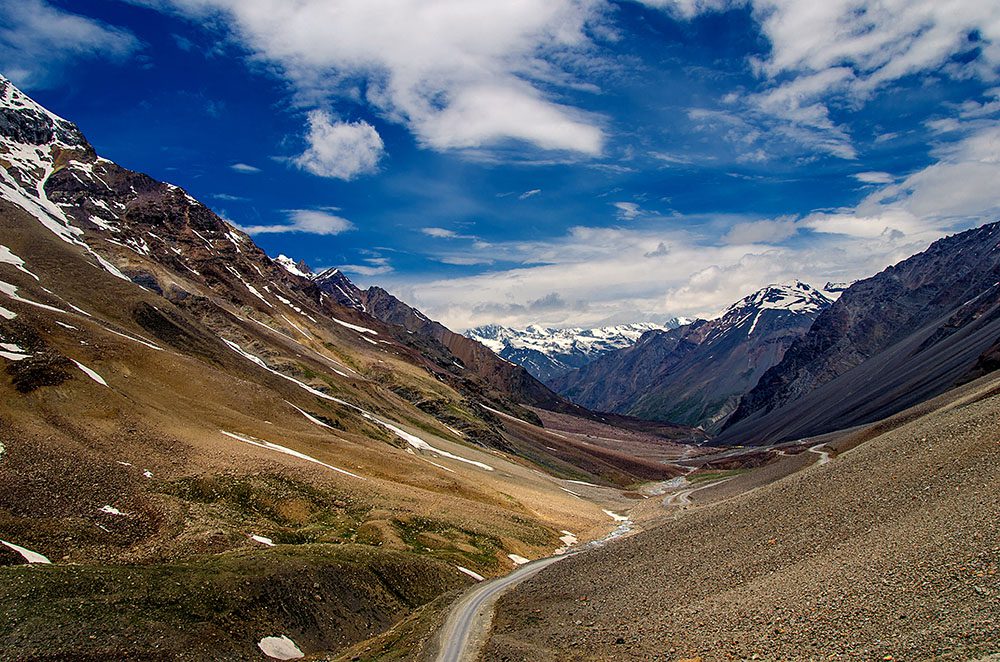
Bike Trip vs. Car Trip: What to Choose?
One of the most exciting questions when planning the Manali to Leh road trip is: Should you go by bike or by car? Both options offer unique perspectives, challenges, and rewards. Your choice depends on your travel goals, experience level, physical endurance, and how close you want to get to the raw Himalayan elements.
The Allure of the Motorcycle Adventure:
Riding a bike across the mighty Himalayas has become a bucket-list adventure for many. A bike trip from Manali to Leh lets you feel every gust of wind, smell every pine forest, and experience the terrain in its most intimate form. Whether you’re on a Royal Enfield Classic, Himalayan, or KTM, the ride offers unmatched freedom and adrenaline.
Pros of the Bike Trip:
- Total immersion in the landscape—you’re part of the road, not behind glass.
- Easier to maneuver around rocks, river crossings, and narrow passes.
- Ideal for solo travelers or tight-knit groups of bikers.
- More interaction with locals and fellow travelers.
Cons of the Bike Trip:
- Physically exhausting—cold winds, long rides, and altitude fatigue hit harder.
- Limited space for gear and supplies—packing smart is critical.
- Weather exposure—riders must prepare for snow, rain, and sudden temperature drops.
- Not ideal for first-time high-altitude travelers or those with back problems.
The Comfort of a Car or SUV Road Trip:
If comfort, safety, and gear storage are priorities, a car trip is the better choice. A self-drive trip from Manali to Leh gives you climate control, music, rest breaks, and the ability to carry food, oxygen, and emergency kits with ease.
Pros of a Car Trip:
- Protection from weather and dust storms.
- More comfortable for families or groups.
- Ample space for luggage, camera gear, food, and fuel cans.
- Less physical strain, making it easier to acclimatize and relax.
Cons of a Car Trip:
- Less “raw” experience—disconnect from sounds and smells of the mountains.
- Challenging to navigate in narrow passes and steep switchbacks.
- Dependence on road condition updates—mudslides and blockages affect cars more than bikes.
Choosing the Right Vehicle:
If you opt for a car, go for a high-clearance vehicle—preferably a 4×4 SUV like Scorpio, Thar, Fortuner, or Duster AWD. Avoid low-slung sedans which may struggle at water crossings or broken tarmac sections. For bikes, Royal Enfield 500cc and above are ideal for torque, stability, and load-bearing. Dual-sport or adventure bikes also fare well.
What’s Right for You?
- Traveling Solo or as a Couple? A bike gives freedom and thrill.
- With Family or Elderly Members? A car offers safety and ease.
- Photography Enthusiast? A car provides room for gear and stable shooting setups.
- Adrenaline Seeker? A bike will fuel your soul.
In the end, whether you’re roaring through valleys on a motorcycle or cruising with friends in an SUV, the Manali to Leh highway will leave a mark on your spirit. The key is to respect the mountains, prepare well, and choose the ride that matches your heart—not just your engine.
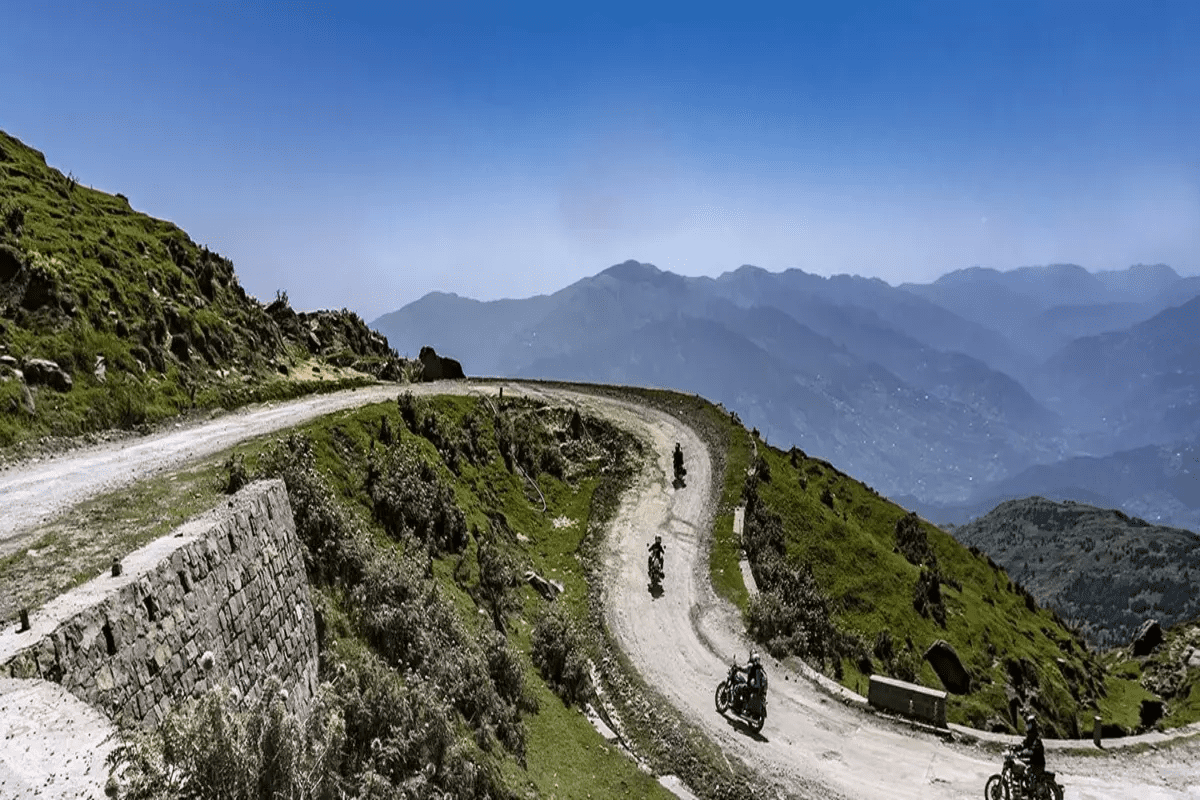
Responsible & Sustainable Travel Tips
The Manali to Leh road trip takes you through some of the most pristine and fragile ecosystems on Earth. Towering mountains, turquoise rivers, alpine meadows, and remote settlements welcome you with breathtaking beauty—but they also whisper a plea: “Tread lightly.” Traveling responsibly in the Himalayas isn’t just a suggestion—it’s a duty. The region’s increasing popularity has brought with it a rising impact, from littered campsites to cultural insensitivity. But your choices can shape a better future for Ladakh.
1. Leave No Trace – Pack In, Pack Out:
Everything you bring should leave with you. From plastic wrappers to tissue papers and bottles—dispose of waste responsibly. Avoid single-use plastic altogether. Carry reusable water bottles, metal cutlery, cloth bags, and airtight snack containers. Many parts of the highway have no formal waste disposal system, so it’s up to travelers to follow zero-waste principles.
2. Support Local Communities:
Whenever possible, eat at local dhabas, buy handmade souvenirs, and stay in village-run homestays. This not only provides you with a more authentic experience but helps the local economy thrive. When you spend at a local tent camp in Sarchu or a homestay in Jispa, you’re investing directly into sustainable mountain livelihoods.
3. Respect Traditions and Sacred Spaces:
Ladakh and Lahaul are home to diverse spiritual traditions, from ancient Buddhist monasteries to tribal shrines. Dress modestly, remove your shoes when entering temples, and ask before taking photos—especially of people. Many locals still live by deep spiritual codes, and showing respect opens doors to more meaningful interactions.
4. Be Water Wise:
High-altitude regions suffer from acute water scarcity. Rivers may look full, but usable water is limited. Use water sparingly when washing or bathing. Skip the daily shower—your body will adjust. Avoid using harsh soaps and detergents near streams or lakes. Choose biodegradable toiletries wherever possible.
5. Drive with Care – For People and Wildlife:
Speeding on the Manali to Leh highway is not only dangerous but disrespectful. Yaks, marmots, and mountain goats may cross the road unexpectedly. Honk gently, drive slowly near villages, and always give right of way to livestock. At higher elevations, noise pollution affects even the wildlife—let silence be your soundtrack.
6. Choose Ethical Adventure Operators:
If you’re booking through a travel company, ensure they follow ethical practices: fair wages for staff, waste segregation, and no illegal camping in protected areas. Ask questions before you book. A growing number of operators in Ladakh now offer eco-friendly road trip packages with reduced carbon footprints.
7. Embrace the Slow Travel Mindset:
The Himalayas aren’t a race—they’re a rhythm. Stay longer in fewer places. Listen to stories. Participate in village life. Attend a local festival or help in the fields if invited. The deeper you go, the more you’ll discover that responsible travel is also the most rewarding.
Remember, the landscapes you photograph, the meals you savor, and the silence you treasure exist only because someone protects them. Let your journey through the Manali to Leh highway be one that gives back—to the earth, to the people, and to yourself.
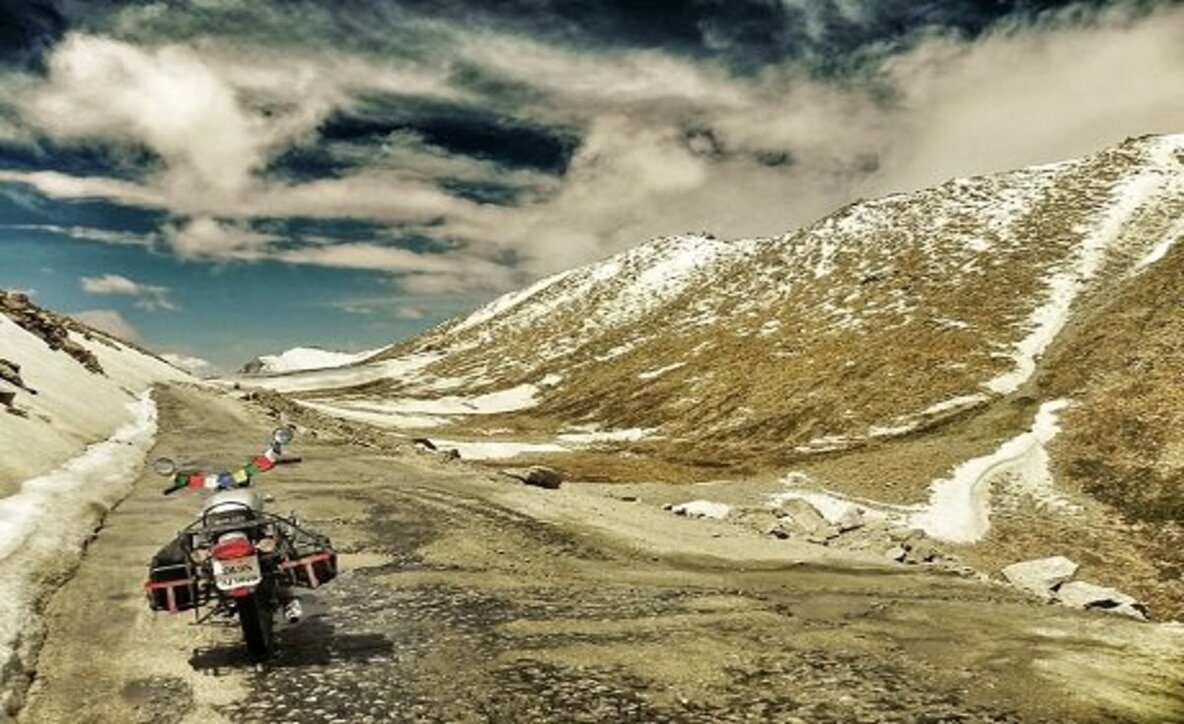
Final Tips to Make Your Manali to Leh Drive Unforgettable
As the dust settles on your tires and the prayer flags flutter behind you, one truth becomes clear—this wasn’t just a road trip. It was a journey through silence, stillness, and awe. And like all great adventures, it lives on in the stories you’ll tell and the moments you’ll never need to explain. But before you close the journal of this Himalayan passage, here are a few final tips to make your Manali to Leh road trip truly unforgettable.
1. Start Early, Arrive Safely:
Every morning on the Manali–Leh route is a race against time and terrain. Start your drive by 6:00 AM to avoid water crossings that swell by afternoon, and to ensure you reach your destination before dark. Early light also makes for stunning photography and peaceful roads.
2. Capture, But Don’t Chase:
While it’s tempting to stop every few kilometers for photos, remember: some moments are best left to memory. That sudden burst of snow at Baralacha La. The lone yak crossing the road near More Plains. The silent prayer wheels spinning in the wind. Capture what you can, but don’t miss the poetry unfolding around you.
3. Share the Road—And Respect It:
The Manali to Leh highway isn’t just for tourists. It’s a lifeline for remote villages, a sacred path for pilgrims, and a battleground for the BRO workers who rebuild it every year. Drive humbly. Give way when needed. Wave back at the shepherds. Slow down for the marmots. Let the road teach you patience.
4. Stay Curious, Not Just Connected:
Phone signals will vanish. Google Maps will stutter. But local wisdom, hand-painted signboards, and intuition will guide you better than 4G ever could. Ask for directions. Chat with locals. Eat where the truckers stop. Let go of the itinerary when the mountains invite you to explore something unplanned.
5. Carry a Travel Journal:
Beyond the selfies and reels, take 10 minutes each night to write down what moved you. The starlit night in Sarchu. The sound of wind echoing at Tanglang La. The taste of butter tea in Upshi. Years from now, these details will transport you back like nothing else.
6. Keep a Buffer Day in Leh:
Once you reach Leh, rest. Don’t rush to Nubra or Pangong the next day. Your body and mind will thank you for the pause. Explore the old town, sip tea at a rooftop cafe, or simply sit and watch the clouds drift over Shanti Stupa.
7. Leave Something Behind – But Not Trash:
Plant a tree, donate to a school, buy a book from a local store, or teach a child how to say “hello” in your language. Leave a smile, not a scar.
The Manali to Leh highway isn’t just geography—it’s mythology, memory, and meaning all rolled into one. Let this journey change how you travel. Let it remind you that the most unforgettable roads are not the ones that take you somewhere, but the ones that bring you closer to yourself.

